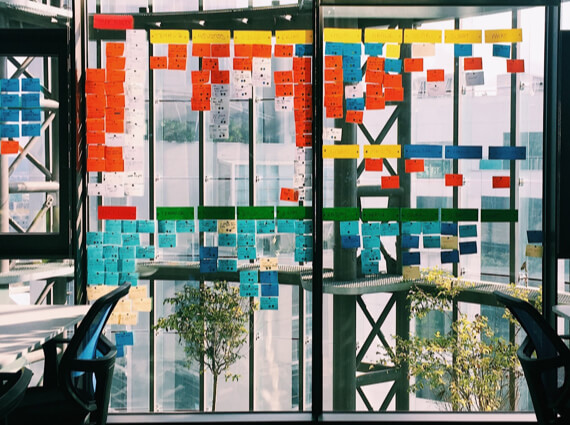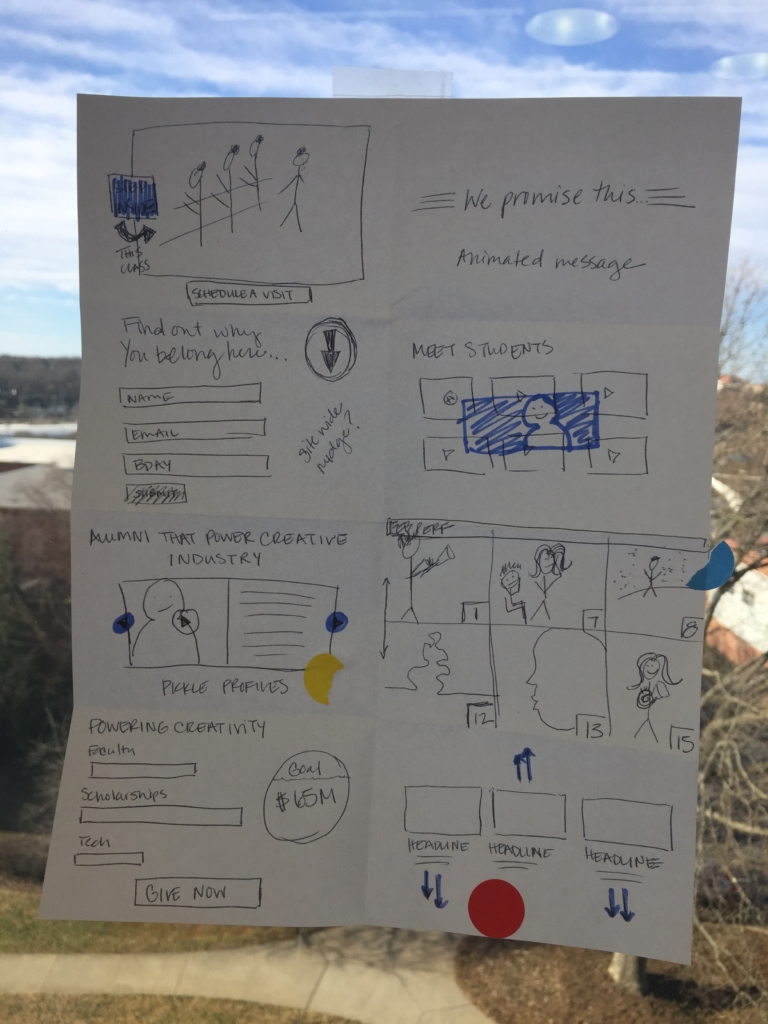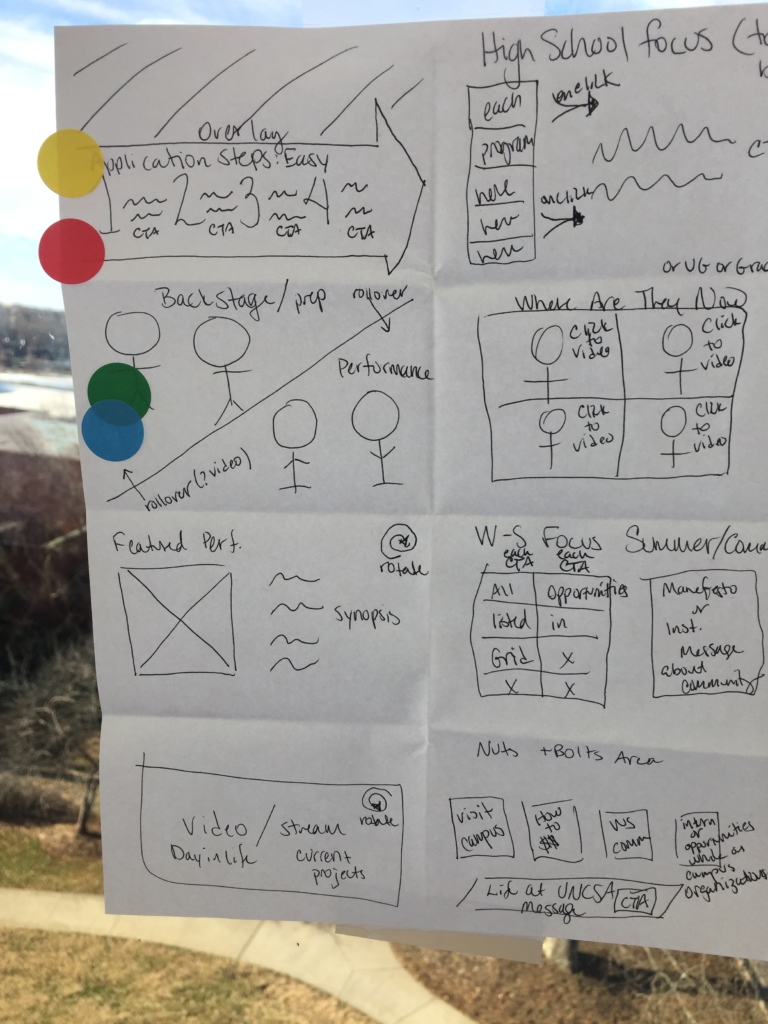


At mStoner, we believe the best way to do creative work is to simply just start making. The process of generating ideas in physical form is absolutely necessary in order to know if a good idea can be great. And subsequently, sharing or testing your ideas with others is the only way to validate the usefulness of a great idea.
The Google-inspired design sprint workshops we conduct with our higher ed clients bring out the best in our design and content strategy work. When we join forces as one team to learn, generate ideas, and make, we build trust in one another and develop a shared vision for goals we’re trying to achieve. Ultimately, we come away with innovative ideas that could never have been born in isolation.
There are many parts that make up a large institutional web design project. And with any redesign, we’re likely interested in identifying opportunities across design, technology, and content, and across various aspects of the site. From program pages to the news hub and faculty bios, opportunities for reinvention abound. It can definitely feel daunting when you know there are lots of parts to tend to.
Yet our time-tested discovery process is all about understanding everything about your institution and your audiences as deeply as possible — warts and all — through stakeholder interviews, focus groups, and experience mapping. Then we prioritize what to tackle and with what level of effort. Where the design sprint comes in, and is most useful, is for developing discrete, creative ideas that will influence your most important audiences to make decisions, take action, and champion your brand.
In our recent work with both the University of North Carolina School of the Arts (UNCSA) and McGill University in Montreal, we’ve focused our sprint on the homepage narrative.
The homepage affords the greatest opportunity to make a big difference in a short amount of time. And generally, the homepage influences the content strategy and the design system of the entire site. We don’t want you to end up with the same cookie-cutter university website: drone image, news and events, social feed, fat footer, etc. The goal is to develop a unique experience that feels like your institution and inspires audiences on a visceral level. The sprints condition your team to experiment in a safe space outside the continuous cycle of the status quo — and to move fast. All you need is, at minimum, two days away from the daily grind, sticky notes, and a room.
First, it’s important to understand that a design sprint is not a brainstorm. Brainstorms don’t work well. We structure our design sprint around individual work and group decision-making. Each participant has an opportunity to generate ideas individually and present to the group. We vote on the best ideas and decide together which to pursue in the next round of ideation.
Our experience with brainstorms is that the loudest person in the room gets their way, while introverts get left behind. mStoner design sprints ensure that the best ideas get visibility, no matter who they come from.
For higher education design sprints, the members who make up the team are people who will actually be designing, coding, creating content for, and managing the website. It’s important to include writers, communicators and marketers from across your campus as well. Those of us whose job it is to sell the institution have a responsibility to come together and develop a shared mission, set goals, and make something we can all be proud to share. The act of simply getting everyone in a room is progress. Without a doubt, ideas will emerge that will push institutional communications to the next level. By bringing a diversity of skills together and creating a democratic space for creative ideation and structured decision-making, we can condense months of meetings and stakeholder reviews into one week.
A big part of generating creative ideas at a sprint is sketching on paper. Once we’ve collected a large amount of opportunities — categorized them, prioritized them, and decided on which to pursue — each individual participant puts pencil to paper to explore an opportunity of their choosing.
Don’t worry! You need zero artistic skills to draw stick figures, boxes, and arrows. The sketches may look like kindergarten art, but it matters little. What’s important is that your sketch is a vehicle for your ideas.

This is the fun part, in our opinion. Once participants get started, it’s hard for them to stop, and the ideas start flowing. It will surprise you how much creative freedom you have when you’ve left your computer behind and you can’t surf the web to scavenge someone else’s ideas. It’s disorienting and primitive at first, but ultimately, it’s a faster way to a brilliant idea — one that no one else in higher ed has thought of yet.
After a few rounds of ideation, we’ll end up with a gallery wall of sketches. We’ll spend time presenting and explaining our ideas to the group. Then we’ll vote on the parts we like, mixing and matching ideas along the way. Ultimately, we’ll end up with a clear idea of what to bring to life with prototype.

A prototype is a more developed model of the end product. It will include content, design, and interactivity to test with real audiences. Because prototyping involves a bit more design skills, this is where mStoner usually takes all the sprint work back to the office and in short order creates a few interactive screens to demonstrate the new design.
At the end of the design sprint, your team will have a prototype and real results from user testing. More important, you’ll have a presentation for leadership. There’s no doubt that you should have a decision-maker on the sprint team, someone who can represent your larger institutional goals. But at some point, you’ll have to share the design.
In addition to having a prototype to show, you’ll have demonstrated that your team can work quickly and collaboratively to generate new ideas, solve important problems, and meet each new challenge head-on. Let’s do this!
Here are three design sprint resources to share with your colleagues:
Ready to start generating ideas with your team?
Bring mStoner to campus for a Design Sprint Workshop. The mStoner-facilitated three-day design sprint combines higher ed knowledge with design expertise to bring the best ideas forward fast, pushing the team toward making and testing those ideas with real website visitors. By the end of the sprint, you and the team will have the ability to address problems immediately and create opportunities that result in a shared vision and real progress.
Ben Bilow Creative Director Creative success comes from digging in, getting messy, and making stuff. As a kid in St. Louis, my interest in skateboarding and rock & roll music shaped my work ethic — be resourceful, build community, share. We invented our own fun, designing rock posters and building half-pipes — tearing them down and doing it again.